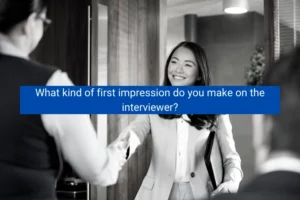Communication is essential for human development during the course of our lives. It is what enables us to communicate our thoughts, feelings, questions, and knowledge to others. Whether you're a verbal or non-verbal communicator, non-verbal Communication accounts for the vast bulk of our interactions.

What is Non-verbal Communication?
The method of conveying and receiving messages without the use of words, spoken or written, is known as meaningless communication or sign language. Non-verbal action can emphasize sections of verbal communication in the same way that italicizing emphasizes written material.
How to Prepare for Video Interview? Click Here>>>
If we're talking about verbal or non-verbal communication, communication is the foundation of our society. The way we communicate affects the connections we form and build at home, with our families and friends, and at work with our coworkers. The way we interact and the relationships we form determine the beauty of our lives.
Few people realize that non-verbal communication is far more significant than verbal communication and that we can't communicate what we want to say if we simply use words. Other aspects of a conversation, such as our body language, hand gestures, tone, facial movements, personal grooming, and clothing, are even more essential. All of these factors play a considerably larger part in a conversation.
Successful Interview Techniques Click Here>>>
When it comes to interviewing preparation, most people focus on verbal communication, but many are unaware of the value of non-verbal communication. According to UCLA research, non-verbal communication accounts for 93% of all communication. The more you practice managing your non-verbal communication skills, the more confident you'll be in interviews.
As a result, if we want to communicate effectively, we must strengthen our non-verbal communication skills! Non-verbal communication aids in the transmission of accurate information!
8 Types of Non-Verbal Communications
What does non-verbal communication include if it accounts for a significant percentage of our communicative experience? Many people connect non-verbal communication with facial expressions and gestures, but these aren't the only two types. In fact, there are eight distinct types of non-verbal communication:
10 Interview Mistakes to Avoid Click Here>>>
- Facial Expression: This is the most common form of non-verbal communication. A smile or frown can communicate a great deal of information. Happiness, sadness, rage, and fear all have comparable facial expressions in different civilizations around the world.
- Gestures: To communicate number amounts, common motions include pointing, waving, and using fingers.
- Paralinguistics: This covers things like voice tone, volume, intonation, and pitch. The tone of one's voice has a lot of power. The same sentence might communicate distinct messages when spoken in different tones. A loud tone of voice can represent approbation or enthusiasm, but a hesitating tone of voice can convey disapproval or lack of interest in the same statement.
Video Marketing – How to Promote Your Business with Video? Click Here>>>
- Body Language and Posture: The way a person stands and moves can also provide a lot of information. Depending on the context and the person reading them, arms crossing or leg crossing can have a variety of meanings. Body language is highly delicate and can be difficult to read.
- Proxemics: This is a reference to one's personal space. The amount of space required by a person is determined by the individual's preferences, as well as the context and other persons involved.
-
Eye Gaze: Eye gaze includes things like looking, staring, and blinking. Looking at someone else can convey a variety of feelings, such as hatred, intrigue, or attraction.
10 Ways to Speed-Up Your Job Search Effort Click Here>>>
- Haptics: This refers to the use of touch to communicate. In infancy and early childhood, haptics is very crucial.
- Appearance: Non-verbal communication is defined as the use of color, dress, hairstyles, and other variables that alter our appearance.
Importance of Non-verbal Communication in Interviews
It's widely known that communication is 7 percent verbal and 93 percent non-verbal, so in an interview, where you have a limited amount of time to make a good impression, it is important to pay attention to your body language.
Most applicants are preoccupied with planning what they will say and how they will respond, rather than assessing their composure, what is acceptable for an interview, and how to enhance it so that they may present their best self at the interview. We've looked at a few strategies to make sure your non-verbal communication is supporting your excellent answers and giving you the greatest possible impression.
15 Tips for Writing Successful Resumes Click Here>>>
Many candidates preparing for job interviews ignore the importance of non-verbal communication. When you get a call for a job interview, you're one step closer to achieving your goal. However, the subsequent phases in this procedure must be handled with extreme caution. Non-verbal communication that is effective increases one's chances of being selected.
Here are some tips to help you improve your meaningful communication.
1. Dressing for Success:
Your appearance, whether good or awful, is critical in making a positive first impression. Do not strictly follow fashion trends, but rather dress decently. Choose neutral yet graceful tones like blue, grey, or black for the suit to make a powerful effect. White and light blue are the most generally acceptable shirt colors. Hairstyles should neither be very formal nor overly casual. Avoid heels and opt for gleaming black polished shoes. Perfumes should not be overused.
10 Steps to Planning Your Job Searches Click Here>>>
2. Take Control of Your Body Language:
During the interview, keep your mind and body alert, and remain cool while waiting for your time. Never get tired or start using the phone. Be attentive and have professional composure. Maintain a professional demeanor while paying attention. During the interview, do not cross your legs or move your legs. Only give a handshake if the respondents ask.
3. Be ecstatic rather than desperate:
In your speech, your facial expressions reflect your feelings. Demonstrate your passion and excitement for the job. Believe in your ability to complete the task and contribute to the company's success. Every move you make throughout the interview should show a positive mental attitude.
10 Toughest Questions to Expect in a Job Interview Click Here>>>
4. Eye-to-Eye Contact:
Make sure your eyes are frequently in contact with the interviewer. Avoid glancing around the room or up at the ceiling or floor. This shows a lack of trust or interest in the dialogue. Pay attention to the interviewer's non-verbal cues; if he appears distracted or bored, use more relevant words or topics.
5. Be Well-Prepared:
Bring all of the items you'll need for the interview. Keep all of your essential paperwork organized in a file. Avoid stuffing them into your pocket, bag, or old envelope. Non-verbal communication is also influenced by your assets. Any significant item missing from the dossier could result in a point deduction.
How to Give a Professional Touch to your CV? Click Here>>>
6. At the End of the Interview, Non-verbal Communication
In this perspective, the interview's conclusion is unquestionably the most crucial point. In most cases, the candidate's final gesture is sufficient to determine whether or not you will be chosen. Lastly, remember the silent message you give. Don't rush out the door. Thank everyone for coming, smile at the entire panel, and walk out of the room with confidence.
The power of non-verbal communication outweighs the power of spoken communication. Prepare thoroughly for the interview. In front of the mirror, practice. Doing video recordings can be helpful during editing.
For Human Resource, Payroll and many more HR Services, visit our website https://lingueeglobal.com/



